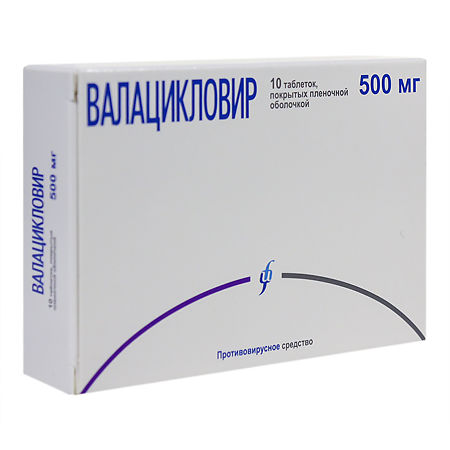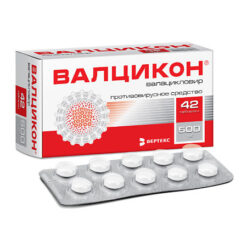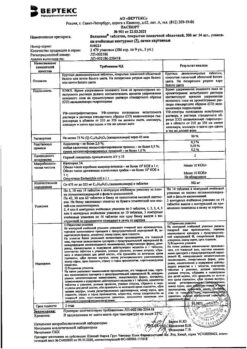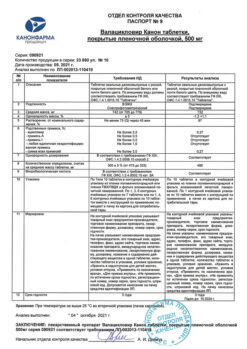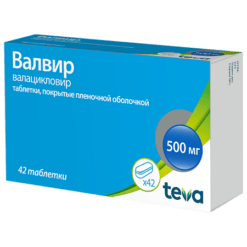No products in the cart.
Description
An antiviral agent of the group of nucleoside analogues. Valacyclovir is an L-valine ester of acyclovir, thus being a prodrug.
After absorption into the blood, valacyclovir is almost completely converted to acyclovir by hepatic enzyme valacyclovir hydrolase. Aciclovir formed from valacyclovir, in its turn, penetrates into virus-infected cells, where it is transformed into monophosphate under the influence of the viral enzyme thymidine kinase and then into diphosphate and active triphosphate under the influence of cellular kinases.
Aciclovir triphosphate inhibits DNA polymerase and thus disrupts DNA replication of the virus. In addition, disruption of viral DNA replication may result from the incorporation of acyclovir into its structure.
Thus, the high selectivity of valacyclovir against tissues affected by the virus is explained by the fact that stage I of the chain of phosphorylation reactions is mediated by an enzyme produced by the virus itself.
It is active against Herpes simplex viruses types 1 and 2, Varicella zoster, cytomegalovirus, Epstein-Barr virus, human herpes virus 6.
Pharmacokinetics
After oral administration valacyclovir is well absorbed from the gastrointestinal tract and is quickly and almost completely converted to acyclovir and L-valine under the action of valacyclovirhydrolase enzyme.
After a single dose of 0.25-2 g of valacyclovir, the Cmax of acyclovir in healthy volunteers with normal renal function averages 10-37 µmol (2.2-8.3 µg/mL) and is reached after 1-2 hours.
The bioavailability of acyclovir when taken from 1 g of valacyclovir is 54% and is independent of food intake.
The Cmax of valacyclovir in plasma is only 4% of that of acyclovir and is reached on average 30-100 min after drug administration; after 3 h the Cmax level remains the same or decreases.
The binding of valacyclovir to plasma proteins is very low – 15%.
In patients with normal renal function the T1/2 of acyclovir is about 3 hours. Valacyclovir is excreted with the urine, mainly as acyclovir (more than 80% of the dose) and its metabolite 9-carboxymethoxymethylguanine, less than 1% of the drug is excreted unchanged.
In patients with terminal renal failure, the T1/2 of acyclovir is approximately 14 hours.
In late pregnancy, the sustained daily AUC after taking 1 g of valacyclovir was approximately 2 times greater than that of acyclovir at a dose of 1.2 g/day.
In organ transplant recipients receiving valacyclovir at a dose of 2 g 4 times daily, the Cmax of acyclovir was equal to or greater than that of healthy volunteers receiving the same dose of valacyclovir, and their daily AUCs were significantly higher.
Indications
Indications
Treatment and prevention of infections caused by Herpes zoster.
Prevention of cytomegalovirus infection developing in organ transplants.
Active ingredient
Active ingredient
How to take, the dosage
How to take, the dosage
A single dose for adults is 0.25-2 g when administered orally. Frequency of administration and duration of treatment depend on the indication.
Patients with severe renal dysfunction require adjustment of the dosing regimen.
Interaction
Interaction
No clinically significant interaction of valacyclovir with other medicinal products was found.
Aciclovir is excreted unchanged in the urine as a result of active tubular secretion.
Any drugs that are administered simultaneously with it and compete for this elimination mechanism may cause increased plasma concentrations of valacyclovir.
Cimetidine and drugs that block tubular secretion, when administered after a dose of 1 g of valacyclovir, increase the AUC for acyclovir and decrease its renal clearance.
Concomitant administration of acyclovir and the inactive metabolite mycophenolate mofetil (an immunosuppressant used in transplantation) increased the AUC of acyclovir and mycophenolate mofetil.
In concomitant use of valacyclovir with drugs that impair renal function (including cyclosporine, tacrolimus), renal function may be impaired.
Special Instructions
Special Instructions
Elderly patients should increase fluid intake during treatment.
Patients with renal insufficiency have an increased risk of neurological complications when taking valacyclovir.
With caution, use in patients with liver disease.
There is no clinical experience with use in children.
Contraindications
Contraindications
Hypersensitivity to valacyclovir, acyclovir.
Side effects
Side effects
On the digestive system: nausea, discomfort, abdominal pain, vomiting, diarrhea, anorexia; rarely – transient increase in liver function tests.
CNS: headache, fatigue, dizziness, confusion, hallucinations; rarely – disorders of consciousness; in some cases – coma (usually in patients with renal dysfunction or other predisposing factors).
Allergic reactions: rash, urticaria, pruritus, angioedema, anaphylaxis are rare.
Others: rare – thrombocytopenia, shortness of breath, renal dysfunction, photosensitization.
Similarities
Similarities
Additional information
| Weight | 0.020 kg |
|---|---|
| Manufacturer | Izvarino Pharma, Russia |
| Medication form | pills |
| Brand | Izvarino Pharma |
Other forms…
Related products
Buy Valacyclovir, 500 mg 10 pcs with delivery to USA, UK, Europe and over 120 other countries.

